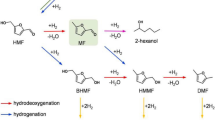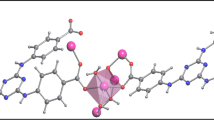Abstract
Non-hydrolytic sol–gel synthesis provides a low temperature solution based approach to solid-state materials. In this work, reactions of TaX5 (X = F, Cl, Br, I) with the thio-ethers di-tert-butylsulfide and hexamethyldisilathiane were carried out in chloroform or acetonitrile. The influence of synthetic parameters such as temperature, reaction time, starting sulfur to tantalum ratio, and solvent volume were explored, and optimized conditions for the preparation of phase pure crystalline TaS2 were established. Amorphous powders were recovered for most of the samples, but crystalline 1T- and 3R-TaS2 modifications could be selectively prepared by heat treatments of the as-recovered precursors at 700 and 800 °C, respectively. The crystallite sizes could be adjusted by tuning the starting sulfur to tantalum ratios, and by choice of solvent. For specific conditions, nanocrystalline 1T-TaS2 was directly recovered from solution. To our knowledge, this is the first time that crystalline TaS2 was directly obtained from low temperature solution based routes.







Similar content being viewed by others
References
Wilson JA, Di Salvo FJ, Mahajan S (1974) Charge-density waves in metallic, layered, transition-metal dichalcogenides. Phys Rev Lett 32(16):882–885
Butz T, Lerf A, Besenhard JO (1984) Metastable configurations during lithium intercalation into 2 h-Tas2. Rev Chim Miner 21(4):556–587
Butz T, Saitovitch H, Lerf A (1979) Kinetics of lithium intercalation into 2H-Tas2 studied by tantalum hyperfine spectroscopy. Chem Phys Lett 65(1):146–149
Gamble FR, Osiecki JH, Cais M, Pisharody R, DiSalvo FJ, Geballe TH (1971) Intercalation complexes of Lewis bases and layered sulfides: a large class of new superconductors. Science 174(4008):493–497. doi:10.1126/science.174.4008.493
Voorhoeve JM, van den Berg N, Robbins M (1970) Intercalation of the niobium–diselenide layer structure by first-row transition metals. J Solid State Chem 1(2):134–137. doi:10.1016/0022-4596(70)90003-4
Gamble FR, Osiecki JH, DiSalvo FJ (1971) Some superconducting intercalation complexes of TaS2 and substituted pyridines. J Chem Phys 55(7):3525–3530
Wu X-C, Tao Y-R, Gao Q-X (2009) Fabrication of TaS2 nanobelt arrays and their enhanced field-emission. Chem Commun 40:6008–6010
Wu XC, Tao YR, Hu YM, Song Y, Hu Z, Zhu JJ, Dong L (2006) Tantalum disulfide nanobelts: preparation, superconductivity and field emission. Nanotechnology 17(1):201–205. doi:10.1088/0957-4484/17/1/033
Rao CNR, Pisharody KPR (1976) Transition metal sulfides. Prog Solid State Chem 104(Pt 4):207–270. doi:10.1016/0079-6786(76)90009-1
Jellinek F (1962) The system tantalum–sulfur. J Less Common Met 4(1):9–15. doi:10.1016/0022-5088(62)90053-x
Bjerkelund E, Fermor JH, Kjekshus A (1966) On the properties of TaS3 and TaSe3. Acta Chem Scand 20:1836–1842
Franzen HF, Smeggil JG (1969) Two new subsulfides of tantalum. J Am Chem Soc 91(10):2814–2815. doi:10.1021/ja01038a086
Kim SJ, Nanjundaswamy KS, Hughbanks T (1991) Single-crystal structure of tantalum sulfide (Ta3S2). Structure and bonding in the Ta6Sn (n = 1,3,4,5?) pentagonal–antiprismatic chain compounds. Inorg Chem 30(2):159–164. doi:10.1021/ic00002a004
Tenne R, Seifert G (2009) Recent progress in the study of inorganic nanotubes and fullerene-like structures. Ann Rev Mater Res 39(1):387–413. doi:10.1146/annurev-matsci-082908-145429
Rao CNR, Govindaraj A (2009) Synthesis of inorganic nanotubes. Adv Mater 21(42):4208–4233. doi:10.1002/adma.200803720
Rapoport L, Bilik Y, Feldman Y, Homyonfer M, Cohen SR, Tenne R (1997) Hollow nanoparticles of WS2 as potential solid-state lubricants. Nature 387(6635):791–793. http://www.nature.com/nature/journal/v387/n6635/suppinfo/387791a0_S1.html
Lopez-Sanchez O, Lembke D, Kayci M, Radenovic A, Kis A (2013) Ultrasensitive photodetectors based on monolayer MoS2. Nat Nano 8(7):497–501. doi:10.1038/nnano.2013.100
Butler SZ, Hollen SM, Cao LY, Cui Y, Gupta JA, Gutierrez HR, Heinz TF, Hong SS, Huang JX, Ismach AF, Johnston-Halperin E, Kuno M, Plashnitsa VV, Robinson RD, Ruoff RS, Salahuddin S, Shan J, Shi L, Spencer MG, Terrones M, Windl W, Goldberger JE (2013) Progress, challenges, and opportunities in two-dimensional materials beyond graphene. ACS Nano 7(4):2898–2926
Novoselov KS, Jiang D, Schedin F, Booth TJ, Khotkevich VV, Morozov SV, Geim AK (2005) Two-dimensional atomic crystals. Proc Natl Acad Sci USA 102(30):10451–10453
Radisavljevic B, Radenovic A, Brivio J, Giacometti V, Kis A (2011) Single-layer MoS2 transistors. Nat Nanotechnol 6(3):147–150
Coleman JN, Lotya M, O’Neill A, Bergin SD, King PJ, Khan U, Young K, Gaucher A, De S, Smith RJ, Shvets IV, Arora SK, Stanton G, Kim HY, Lee K, Kim GT, Duesberg GS, Hallam T, Boland JJ, Wang JJ, Donegan JF, Grunlan JC, Moriarty G, Shmeliov A, Nicholls RJ, Perkins JM, Grieveson EM, Theuwissen K, McComb DW, Nellist PD, Nicolosi V (2011) Two-dimensional nanosheets produced by liquid exfoliation of layered materials. Science 331(6017):568–571
Dunnill CW, Edwards HK, Brown PD, Gregory DH (2006) Single-step synthesis and surface-assisted growth of superconducting TaS2 nanowires. Angew Chem Int Ed 45(42):7060–7063. doi:10.1002/anie.200602614
Dunnill CW, MacLaren I, Gregory DH (2010) Superconducting tantalum disulfide nanotapes; growth, structure and stoichiometry. Nanoscale 2(1):90–97
Li P, Stender CL, Ringe E, Marks LD, Odom TW (2010) Synthesis of TaS2 nanotubes from Ta2O5 nanotube templates. Small 6(10):1096–1099. doi:10.1002/smll.201000226
Chick KY, Nath M, Parkinson BA (2006) TaS2 nanoplatelets produced by laser ablation. J Mater Res 21(5):1243–1247. doi:10.1557/jmr 2006.0148
Enomoto H, Lerner MM (2002) Synthesis of polymer/1T-TaS2 layered nanocomposites. Mater Res Bull 37(8):1499–1507
Wang L, Kanatzidis MG (2001) Laminated TaS2/polymer nanocomposites through encapsulative precipitation of exfoliated layers. Chem Mater 13(10):3717–3727
Manriquez V, Ruizleon D, Lara N, Gonzalez G (1995) Layered transition-metal dichalcogenides MX2 (M = Nb, Ta X = S, Se, Te)—structure of new phases of tantalum derivatives and intercalation of conducting polymers. Bol Soc Chil Quim 40(2):213–217
Nicolosi V, Chhowalla M, Kanatzidis MG, Strano MS, Coleman JN (2013) Liquid exfoliation of layered materials. Science 340(6139):1420–1421
Schuffenhauer C, Parkinson BA, Jin-Phillipp NY, Joly-Pottuz L, Martin JM, Popovitz-Biro R, Tenne R (2005) Synthesis of fullerene-like tantalum disulfide nanoparticles by a gas-phase reaction and laser ablation. Small 1(11):1100–1109. doi:10.1002/smll.200500133
Andrianainarivelo M, Corriu R, Leclercq D, Mutin PH, Vioux A (1996) Mixed oxides SiO2–ZrO2 and SiO2–TiO2 by a non-hydrolytic sol–gel route. J Mater Chem 6(10):1665–1671. doi:10.1039/jm9960601665
Vioux A (1997) Nonhydrolytic sol–gel routes to oxides. Chem Mater 9(11):2292–2299. doi:10.1021/cm970322a
Schleich DM, Martin MJ (1986) Synthesis of novel molybdenum chalcogenides. J Solid State Chem 64(3):359–364. doi:10.1016/0022-4596(86)90079-4
Martin MJ, Qiang GH, Schleich DM (1988) New low-temperature synthesis of transition-metal sulfides. Inorg Chem 27(16):2804–2808. doi:10.1021/ic00289a013
Bensalem A, Schleich DM (1988) Novel low temperature synthesis of titanium sulfide. Mater Res Bull 23(6):857–868. doi:10.1016/0025-5408(88)90080-3
Bensalem A, Schleich DM (1990) Low temperature preparation of amorphous niobium sulfide. Mater Res Bull 25(3):349–356. doi:10.1016/0025-5408(90)90107-d
Bensalem A, Schleich DM (1991) Low-temperature synthesis of vanadium sulfides. Inorg Chem 30(9):2052–2055. doi:10.1021/ic00009a021
Pedoussaut NM, Lind C (2008) Facile synthesis of troilite. Inorg Chem 47(2):392–394. doi:10.1021/ic701636h
Zhou X, Soldat AC, Lind C (2014) Phase selective synthesis of copper sulfides by non-hydrolytic sol–gel methods. RSC Adv 4(2):717-726
Carmalt CJ, Dinnage CW, Parkin IP, Peters ES, Molloy K, Colucci MA (2003) The use of hexamethyldisilathiane for the synthesis of transition metal sulfides. Polyhedron 22(9):1255–1262. doi:10.1016/s0277-5387(03)00114-1
Loktev VM (1999) On sign reversal of the linear thermal expansion coefficient of fullerite C-60 at helium temperatures. Low Temp Phys 25(10):823–825
ICDD (2006) Powder diffraction file. International Centre for Diffraction Data, Newtown Square
Acknowledgments
This work was supported under National Science Foundation Grant DMR-1005911. The Scanning Electron Microscope was purchased under Grant CRIF-0840474.
Author information
Authors and Affiliations
Corresponding author
Rights and permissions
About this article
Cite this article
Zhou, X., Heinrich, C.P., Kluenker, M. et al. Non-hydrolytic sol–gel synthesis of tantalum sulfides. J Sol-Gel Sci Technol 69, 596–604 (2014). https://doi.org/10.1007/s10971-013-3262-8
Received:
Accepted:
Published:
Issue Date:
DOI: https://doi.org/10.1007/s10971-013-3262-8




